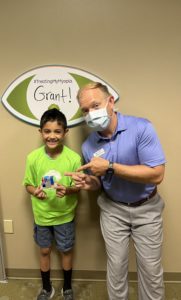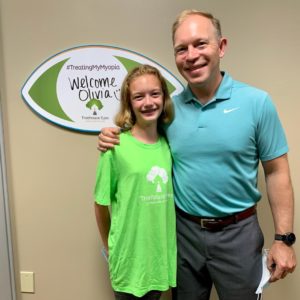sponsored content
November 15, 2022
By Chris Browning, OD
If you want to do myopia management and do it well, you have to dedicate time to commit to it. You have to be all in to do it well.
As a -10.00D myope, I would have to go to my eye doctor every six months to get my glasses and contacts prescription increased. It was during those regular trips that I knew I wanted to become an eye doctor and help not only the people I had grown up with, but also those who were like me with high levels of myopia.
When I first started practicing, I never felt like I was doing my myopic patients justice by just giving them stronger glasses and contacts every year. By the time my daughter was 9 years old, she was already a -2.75D myope, and I knew where she was headed and how debilitating it is to live as a -10.00D myope. She became my first orthokeratology patient, and now she’s 18 and still at -2.75D.
Getting Involved with Treehouse Eyes
When I first started offering OrthoK, I was just dabbling. It was working with Treehouse Eyes that really opened my eyes to other ways of myopia management. Sometimes OrthoK isn’t the best treatment option, and there are limits to approvals. At the time, I wasn’t comfortable prescribing atropine, and I didn’t have any experience using soft lenses for myopia management. There were brands and philosophies I had never heard of until we joined Treehouse Eyes, and the benefit of joining from my standpoint was that it opened my eyes to a whole new range of ways to help kids that I otherwise wouldn’t have been able to help. Of course, beyond just this “clinical awakening,” the practice management benefits that I discuss below were game changing for our practice.
My practice first signed up with Treehouse Eyes in late summer 2019, and by November, we had completed their comprehensive training. We were working toward setting up our office to treat myopia management patients. Then Covid hit, and we were just trying to survive and reopen the practice. By July 2020, we recommitted to Treehouse Eyes, and that’s when we really started with it. Though it took us some time to get the ball rolling, we’re at the point now where we’re signing up about 10 to 12 kids a month in a myopia management treatment plan. Before working with Treehouse Eyes, we would have about five or six kids a year fit into OrthoK for myopia management. We now have a couple of hundred kids in treatment. Keep in mind, we practice in Indianapolis — not exactly the recognized epicenter of childhood myopia.
Connecting with Patients to Create a Treatment Plan
I treat every myopia patient on a case-by-case basis, and Treehouse Eyes’ proprietary, evidence-based treatment protocol has been beneficial to have in the exam room. It gives me a blueprint of which treatment would be best for each patient based on their medical history, genetics, current research, etc. As I present parents and patients with the science and the studies of why a particular treatment option would be best, I also relay my own experience of having both of my kids in two different myopia management treatments. (I started my son on low-dose atropine when he was 11).
Every kid is unique, as is every kid-parent relationship. Treehouse Eyes’ extensive consumer research around parent personality profiles comes into play with each of those relationships. Their training on how to deal with different parent types is proving invaluable and is an important reason for our success. There are certain foundations regarding talking to parents. What’s most important to me is when I walk into the exam room. I always sit down and talk directly to the child. If they have a shirt with a character on it, I’ll talk to them about that. If they have soccer cleats on, I ask them what position they play, when their next game is, and what other sports they play. I want to make that connection with the child before we get into the exam. We don’t talk about eyeballs at all — we talk about what they’re into, what they like, who their friends are, what they ate for lunch today, what their favorite subject in school is, and what they want to do when they grow up. And I do it within the context of my Treehouse Eyes parent personality type training.
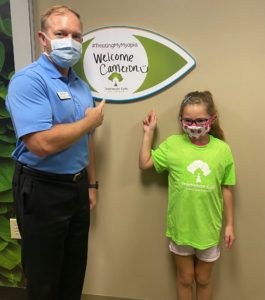 |
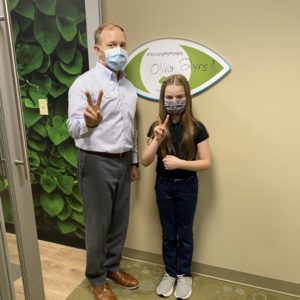 |
Dr. Browning works hard to create connections with his young patients with myopia.
When it comes to the treatment plan, I’ll meet weekly with our Myopia Treatment Coordinator (also trained by Treehouse Eyes) and discuss every kid who is coming in that week and every consult we’re going to do. We look at all the data and develop a game plan for each child of what our primary, secondary, and sometimes even tertiary treatment plan recommendations will be. Sometimes, once I have a conversation with a kid for a few minutes, I’ll know that our primary treatment plan won’t work, and we have to adjust and go with our second option. But having that connection with a child before the exam is important to learning about them and determining how they’ll succeed in myopia management.
Finding Success in Myopia Management
This year, I was acknowledged by Treehouse Eyes as their Myopia Practitioner of the Year, which was incredibly gratifying. Many of the people involved in Treehouse Eyes are people I look up to and are leaders in our profession. To be recognized in this way inside our group is pretty rewarding. I’ve learned something new every day from working with other Treehouse Eyes practitioners, and knowing that our colleagues recognized our commitment to this process is incredible. When you sign up with Treehouse Eyes, you get a lot of tools and resources, and I’m happy that we’ve been able to utilize those tools and help as many kids as possible.
Any recognition our practice has gotten is all due to our outstanding staff. Alison Purvis, our Myopia Treatment Coordinator, and my partner Dr. Anjali Shah have worked so hard for our practice, and it’s all because they’ve seen what myopia management can do for kids.
Going All in on Myopia Management
Optometry is busy and complicated — especially if you’re trying to do things well. You’re trying to run a small business, a retail, and a medical practice. You’re usually the H.R. rep, the accountant, the legal advisor, and the clinical director. If you want to do myopia management and do it well, you have to dedicate time to commit to it. You have to be all in to do it well. I appreciate Treehouse Eyes because I don’t have to find the information myself. They have people whose job it is to find the information and put it in front of me so I can digest it and then pass it along to our patients and give them better outcomes. That information comes in the way of practice management, marketing, and clinical care.
Our industry needs to continue getting the word out there among eye care professionals — you either need to offer full scope, non-dabbling myopia management or refer your patients to doctors who practice full scope, comprehensive myopia management care. It’s not okay to see these kids and just keep giving them stronger glasses and contacts every year. The standard of care now is to manage myopia — not just compensate for blurry vision. I think this mindset shift is significant for kids and families because we can work to prevent a lot of debilitating eye diseases in the future with these treatments. We don’t have to keep putting up with this — we can do something about it. My journey in doing something — in going from dabbler to myopia practitioner of the year — was facilitated by Treehouse Eyes. How will you start your important journey?
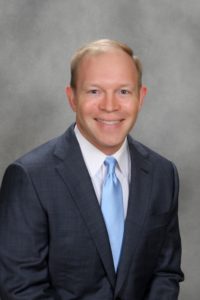 |
Dr. Chris Browning grew up on the south side of Indianapolis, and it was his dream to be able to come “home” and provide eye care to the community where he grew up. He graduated from Indiana University School of Optometry in 2002 and trained in a variety of settings, including pediatric care, ocular surgery, and geriatric and ocular disease at the VA in Fort Wayne. Being extremely nearsighted himself, Dr. Browning has a passion for myopia management and utilizes the latest technology to provide the most personalized solutions for children under his care. He is a frequent lecturer and thought leader among his peers in the field of myopia management. He has been a clinical investigator for studies with Bausch & Lomb, Alcon Vision, and several diagnostic instrument platforms. Dr. Browning has been active in the American Optometric Association and served as both the President of the Central Indiana Optometric Society and the Indiana Optometric Association. He was named “Young Optometrist of the Year” by the IOA in 2011. |


